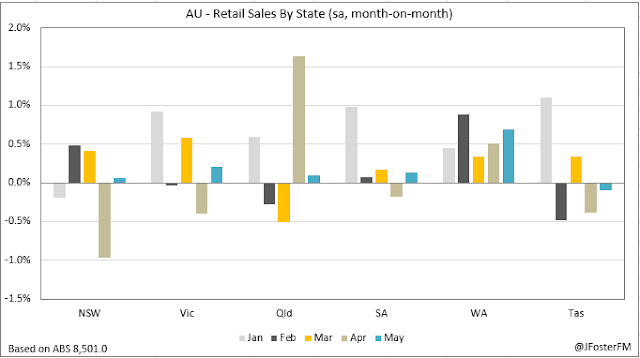The RBA held the cash rate unchanged at 3.85% at today's meeting, as a 6-3 majority on the Monetary Policy Board defied widespread expectations for a 25bps rate cut. The surprise decision forced markets to backpedal, the Australian dollar traded nearly as high as US$0.6550 from $0.6510 pre meeting and a sell-off in the bond market drove the 3-year yield 11bps higher to 3.4% by the close. Having already eased by 50bps with cuts in February and May, Governor Bullock said the Board was maintaining a 'cautious, gradual approach' and today's hold was about 'timing rather than direction'. The Board will await more information - including the June quarter CPI report (due July 30) and new RBA staff forecasts - to confirm that inflation is on track to hold at the midpoint of the 2-3% target band before moving again. The next cut looks likely to come in August - but as today showed, nothing can be assured.
Markets were expecting a cut today only to be surprised as the RBA took a different view on the data and its policy guidance. The misalignment in views only increased as today's meeting drew nearer, largely because a void of policy-relevant speeches or appearances from RBA officials had left expectations for a cut to climb unchecked. At the post-meeting press conference, Governor Bullock pushed back on that version of events, saying that it would not have been appropriate for the RBA to guide markets prior to a meeting. But today's situation is clearly unhelpful to a newly formed Board and to an RBA that has worked to revamp its communications following the review into the central bank.
Today's decision statement effectively revealed that little had changed for the Board since the May meeting. The labour market remains in robust shape, with the Board continuing to judge that conditions are tight. Although economic growth was subdued in the March quarter (0.2%q/q, 1.4%Y/Y), the Board did not see that as posing an increased risk to the expected pick-up in household consumption. Neither was it convinced by the slowing in inflation (2.1%yr headline, 2.4% core) in the monthly CPI gauge for May. In fact, Bullock pointed to upside risks to inflation from the monthly indicator, citing home building and durable goods prices. When it comes to inflation, the line has basically been drawn in the sand that it is only the quarterly CPI reports that the Board is prepared to move on. Further to that, Bullock said the Board will look to the Q2 CPI report to confirm that inflation is falling in line with its forecasts. Should that be the case, a cut is likely on the cards for August.
Events offshore around global trade were still considered highly uncertain, a key factor giving the Board reason to pause. The RBA expects global growth will be weaker due to the US administration's tariff agenda. In an Australian context, the spillover effects on household spending and business investment are what the RBA is waiting to gain greater clarity on. The next RBA monetary policy meeting is on 11-12 August.


























